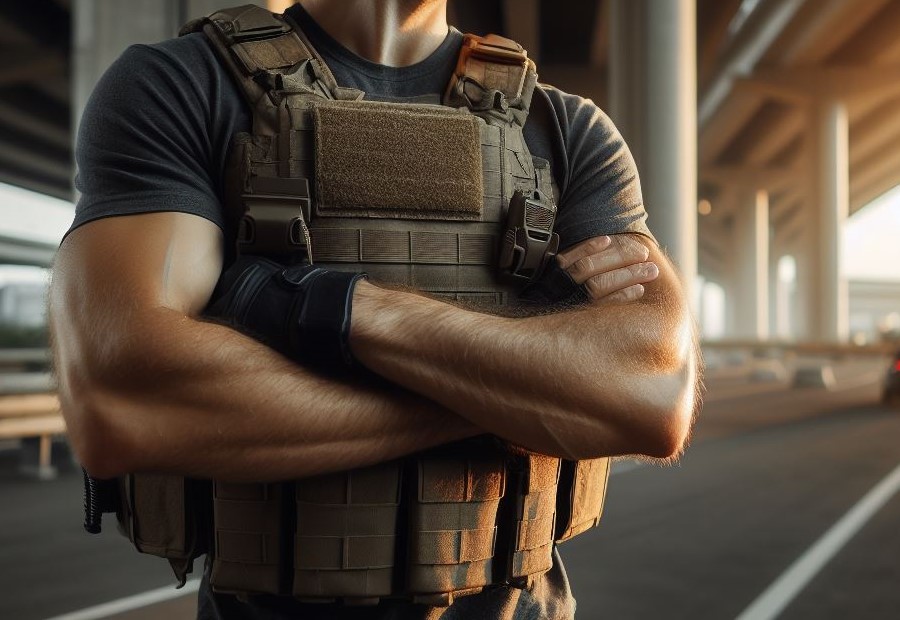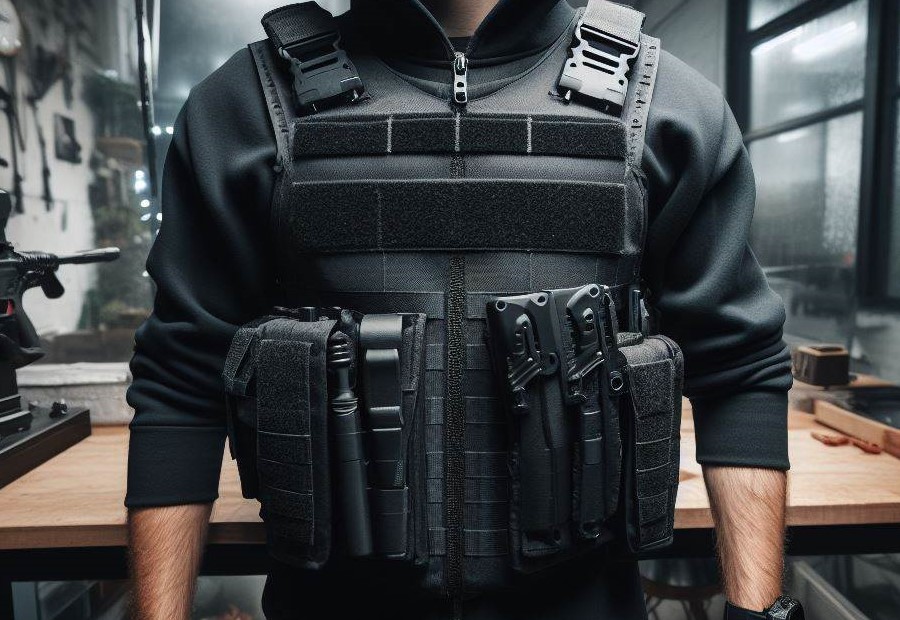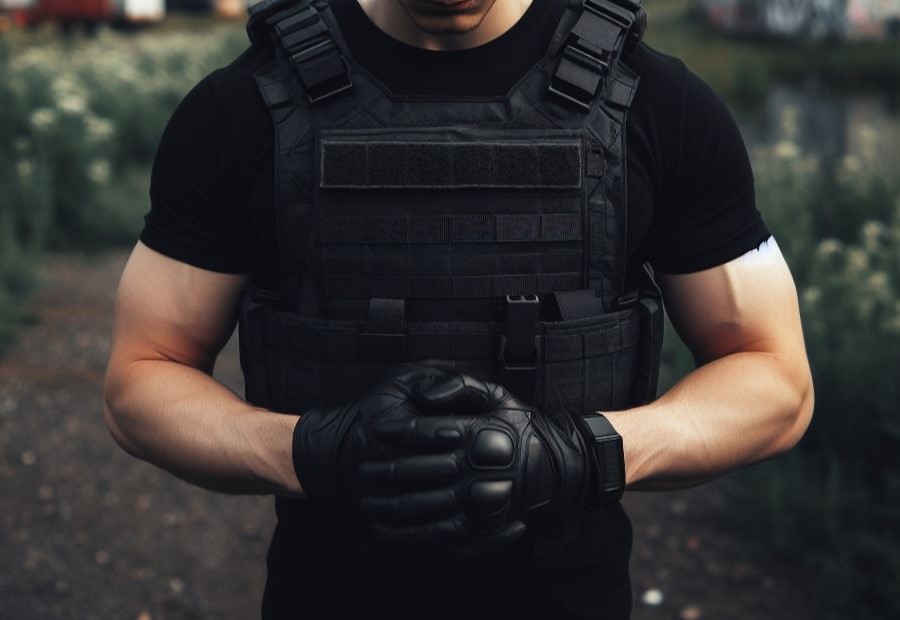In any tactical or operational scenario, the ability to efficiently carry and access essential gear is paramount.
Attaching gear to a tactical vest is a fundamental skill for anyone in law enforcement, military, security, or outdoor activities where quick access to equipment is crucial.
Tactical vests serve as a versatile platform for carrying essential gear such as ammunition, medical supplies, communication devices, and more.
Whether you’re gearing up for a mission, training exercise, or outdoor adventure, knowing how to properly attach gear to your vest ensures readiness and efficiency in the field.
By mastering the art of attaching gear to your tactical vest, you’ll enhance your readiness, mobility, and effectiveness in any operational environment.
Whether you’re on duty, training, or exploring the great outdoors, a well-organized and properly equipped vest is essential for mission success and personal safety.
Types of Tactical Vests

Plate Carriers
Plate carriers are a type of tactical vest that are specifically designed to hold ballistic plates, providing protection against bullets and projectiles.
They are widely used by military personnel, law enforcement officers, and outdoor enthusiasts who prioritize safety and functionality. Here are some key points to consider when it comes to plate carriers:
- Protection: Plate carriers are designed to hold ballistic plates, which are typically made of materials like ceramic or composite. These plates provide protection against various types of ammunition and projectiles.
- Customizability: Plate carriers often feature a modular design, allowing users to attach pouches, holsters, and other accessories as needed. This allows for customization based on the specific mission or activity.
- Comfort and Mobility: Plate carriers should be comfortable to wear for extended periods and should not restrict movement. Adjustable straps and padding are important features to consider.
- Weight Distribution: As ballistic plates can add significant weight to the vest, plate carriers should have a well-designed system for distributing the weight evenly across the user’s body.
- Durability: Plate carriers should be made from high-quality materials that can withstand rugged environments and frequent use. The stitching and closures should be strong and durable.
- Quick Release Mechanism: In emergency situations, a plate carrier with a quick release mechanism can allow for easy removal of the vest, providing swift access to medical assistance or allowing for quick escape.
When choosing a plate carrier, it is crucial to consider your specific needs, the level of protection required, and the intended use. The fit and comfort should be top priorities, as a properly fitted plate carrier will enhance mobility and overall performance in the field.
Chest Rigs
The sub-topic “Chest Rigs” discusses the various types of chest rigs that can be utilized to attach gear to a tactical vest.
- Chest rigs, which are a specific kind of tactical vest, are intended to be worn on the chest.
- They provide a streamlined and lightweight option for carrying essential equipment.
- Chest rigs typically come equipped with multiple pockets and pouches for storing items like magazines, medical supplies, and communication devices.
- Some chest rigs also include a MOLLE (Modular Lightweight Load-carrying Equipment) system, which enables further customization and attachment of pouches and accessories.
- Durable materials like nylon or Cordura fabric are commonly used for constructing chest rigs.
MOLLE Vests
MOLLE Vests are a popular type of tactical vest that provide a versatile and customizable solution for attaching gear. Here are key points to consider:
- MOLLE Webbing: MOLLE Vests feature a webbing system, typically made of durable nylon, that allows for the attachment of various pouches and accessories.
- Modularity: One of the main advantages of MOLLE Vests is their modular design, which means you can easily add, remove, or rearrange pouches and attachments based on your specific needs.
- Attachment Points: MOLLE Vests have rows of webbing that provide multiple attachment points. These attachment points, known as PALS (Pouch Attachment Ladder System), allow for secure and stable attachment of gear.
- Pouches and Accessories: MOLLE Vests offer a wide range of compatible pouches and accessories, including magazine pouches, admin pouches, medical pouches, and more. These pouches can be easily attached and organized on the vest using the MOLLE webbing.
- Customization: With MOLLE Vests, you have the freedom to customize your loadout based on your specific mission or activity. This customization allows you to have quick access to essential gear and ensures optimal weight distribution.
Tools and Equipment Needed
When attaching gear to a tactical vest, there are several tools and equipment needed:
- Multi-purpose pouches: These pouches come in handy for storing small items like a flashlight, multi-tool, or spare batteries.
- MOLLE attachments: These modular attachments provide the versatility to secure different gear and accessories to your vest, such as magazine pouches or a medical kit.
- Gear straps: Strong and durable straps are crucial for securely fastening larger items like a radio or hydration pack to your vest.
- Carabiners: These lightweight clips are excellent for attaching items like gloves or a water bottle to your vest.
Step-by-Step Guide to Attach Gear to a Tactical Vest

Assess Your Gear
When attaching your gear to a tactical vest, it is crucial to assess its suitability and functionality. By following these steps, you can ensure that your gear meets your needs:
- Inspect your gear for any damage or wear. Check for any loose or broken parts that may affect its performance.
- Evaluate the weight and size of your gear. Consider the load-bearing capacity of your vest and determine if your gear can fit comfortably and securely.
- Assess the functionality of your gear. Ensure that each item serves a specific purpose and will contribute effectively to your mission or activity.
- Consider the accessibility of your gear. Determine if your equipment can be easily reached and deployed without hindering your movements or compromising your safety.
- Take into account the versatility of your gear. Consider whether your items can be used in various situations or if they are specialized for specific tasks.
By carefully assessing your gear, you can ensure that you have the right tools and equipment attached to your tactical vest, enhancing your preparedness and effectiveness in the field.
Identify Attachment Points
To effectively identify attachment points on a tactical vest, simply follow these steps:
- Thoroughly examine the vest: Carefully inspect the vest to locate any pre-determined or designated attachment points. Look out for loops, D-rings, or specially designed straps that are intended for attaching gear.
- Check for MOLLE webbing: Keep an eye out for rows of MOLLE (Modular Lightweight Load-carrying Equipment) webbing on the vest. This webbing consists of horizontal rows of nylon straps, providing multiple attachment points for gear.
- Determine compatible areas: Identify the areas on the vest that are compatible with the gear you plan to attach. Keep in mind that some gear may require specific attachment points or may be more secure in certain locations.
- Consider weight distribution: Take into account the weight and distribution of your gear. It’s advisable to attach heavier items closer to the center of gravity and to more stable attachment points. This will help maintain balance and allow for easier movement.
- Test durability: Make sure that the attachment points you have identified are secure, sturdy, and capable of supporting the weight of your gear. It’s important to ensure that they do not compromise the integrity of the vest.
By following these steps, you’ll be able to effectively identify attachment points on your tactical vest.
This will enable you to securely and conveniently attach your gear while maintaining optimal functionality during tactical operations.
Utilize MOLLE System
To effectively utilize the MOLLE system when attaching gear to a tactical vest, follow these steps:
- Assess your gear: Determine which tools and equipment you need to attach to your vest using the MOLLE system.
- Identify attachment points: Locate the MOLLE webbing on your vest where you can securely attach your gear. These are typically rows of nylon straps with small loops.
- Prepare your gear: Ensure that any items you plan to attach to your vest have compatible MOLLE straps or attachments.
- Thread the straps: Insert the straps on your gear through the loops of the MOLLE webbing, making sure they are properly aligned.
- Secure the gear properly: Fasten the straps tightly, ensuring that the items are securely attached to your vest.
- Adjust for comfort and accessibility: Make any necessary adjustments to the positioning of your gear to ensure easy access and comfort during use.
Secure the Gear Properly
To properly secure the gear to a tactical vest, follow these steps:
- Ensure the gear is compatible with the vest and its attachment points.
- Identify the attachment points on the vest where the gear can be securely fastened.
- Utilize the MOLLE system by weaving the gear’s straps through the webbing on the vest.
- Apply enough tension to securely fasten the gear to the vest.
- Double-check that the gear is properly secured by gently tugging on it.
Adjust for Comfort and Accessibility
Adjusting your tactical vest for both comfort and accessibility is crucial for optimal performance in the field. Here are the steps to follow:
- Assess your gear: Prioritize the items you need to have within easy reach and consider their weight and size.
- Identify attachment points: Locate the MOLLE webbing or other attachment systems on your vest where you can secure your gear.
- Utilize the MOLLE system: Attach compatible pouches and accessories to the MOLLE webbing using the appropriate straps or clips, ensuring a secure attachment for both comfort and accessibility.
- Secure the gear properly: Make sure all pouches and accessories are properly fastened and tightened to prevent unwanted movement during operations.
- Adjust for optimal comfort: Adjust the straps and buckles on your vest to achieve a snug and comfortable fit, allowing you to adjust for both comfort and accessibility. This will help distribute the weight evenly and prevent discomfort during prolonged use.
- Ensure easy accessibility: After adjusting for comfort, test the accessibility of your gear. Ensure that you can easily reach and retrieve your items without impeding your movements or compromising your field of view.
Tips and Best Practices
When it comes to attaching gear to a tactical vest, following these tips and best practices is crucial:
- Begin by organizing your gear and determining which items you need to attach.
- Strategically attach pouches and accessories, taking into account weight distribution and accessibility.
- Ensure secure attachment methods, such as MOLLE or Velcro, are used for stability and easy removal.
- Maintain proper balance of the gear on the vest to ensure mobility and comfort.
- Regularly inspect and tighten attachments to prevent any gear from coming loose during use.
- Practice drawing and reholstering equipment to ensure smooth and efficient operation in the field.
Remember, incorporating proper gear attachment techniques is essential for a functional and efficient setup, ultimately enhancing your performance in tactical situations.
Common Mistakes to Avoid

- Using the wrong attachment method. Make sure to use the appropriate straps, clips, or loops that are designed for the specific gear you are attaching to a tactical vest.
- Overloading the vest with too much gear. This can hinder mobility and make it difficult to access essential items quickly. Only carry the necessary gear and distribute the weight evenly.
- Not securing the gear properly. Failing to secure the gear properly can result in items falling off or becoming loose during movement. Always double-check that all attachments are fastened securely.
Frequently Asked Questions
What types of gear can be attached to a tactical vest?
Tactical vests can accommodate various types of gear, including ammunition pouches, magazine holders, medical kits, communication devices, utility pouches, hydration systems, and more.
What is MOLLE, and how does it work for gear attachment?
MOLLE (Modular Lightweight Load-carrying Equipment) is a system of webbing and straps used for attaching gear to tactical vests. Gear with MOLLE compatibility features straps or clips that weave through the webbing for secure attachment.
How do I choose the right attachment method for my gear?
Consider factors such as the type of gear, compatibility with your vest’s attachment points, ease of access, and security. MOLLE, hook-and-loop (Velcro), and specialized attachments like D-rings or straps are common options.
What is the best way to position gear on a tactical vest?
Position gear based on accessibility, weight distribution, and ergonomic principles. Place frequently used items within easy reach, distribute weight evenly to maintain balance, and consider the vest’s design for optimal placement.
How can I ensure that my gear is securely fastened to the vest?
Double-check attachment points to ensure straps are tightly woven through MOLLE webbing, Velcro-backed gear is firmly pressed onto hook-and-loop panels, and other attachments are properly secured. Regularly inspect attachments for any signs of loosening or wear.
What should I do if my gear interferes with movement or comfort?
Conduct mobility tests to identify any areas of discomfort or restriction. Adjust straps, reposition gear, or consider redistributing weight to optimize comfort and range of motion. It may require some trial and error to find the perfect configuration.
How often should I perform maintenance on my gear attachments?
Regularly inspect gear attachments for signs of wear, damage, or loosening. Tighten straps, replace worn components, and clean the vest and gear as needed to ensure optimal functionality and longevity.

